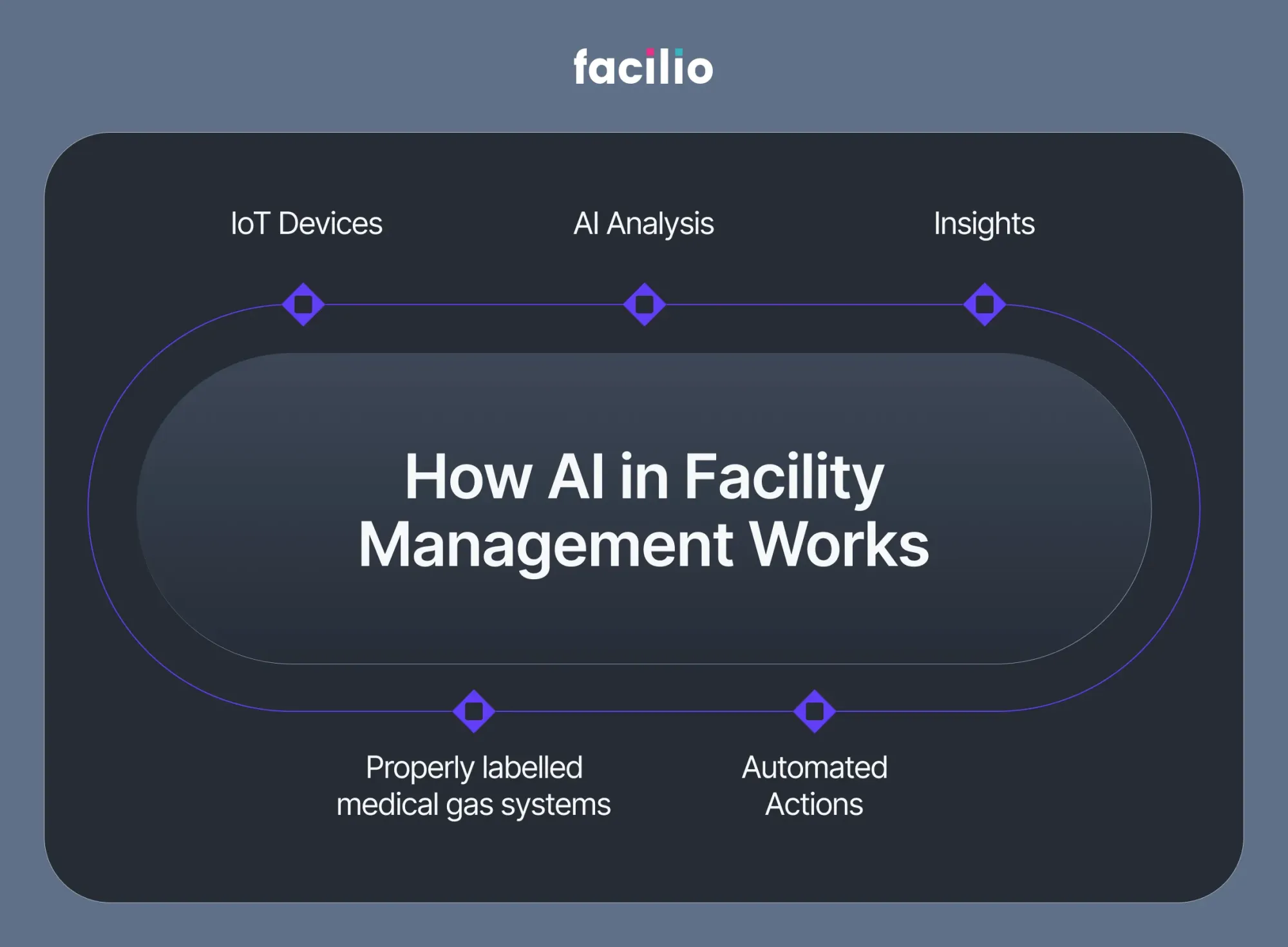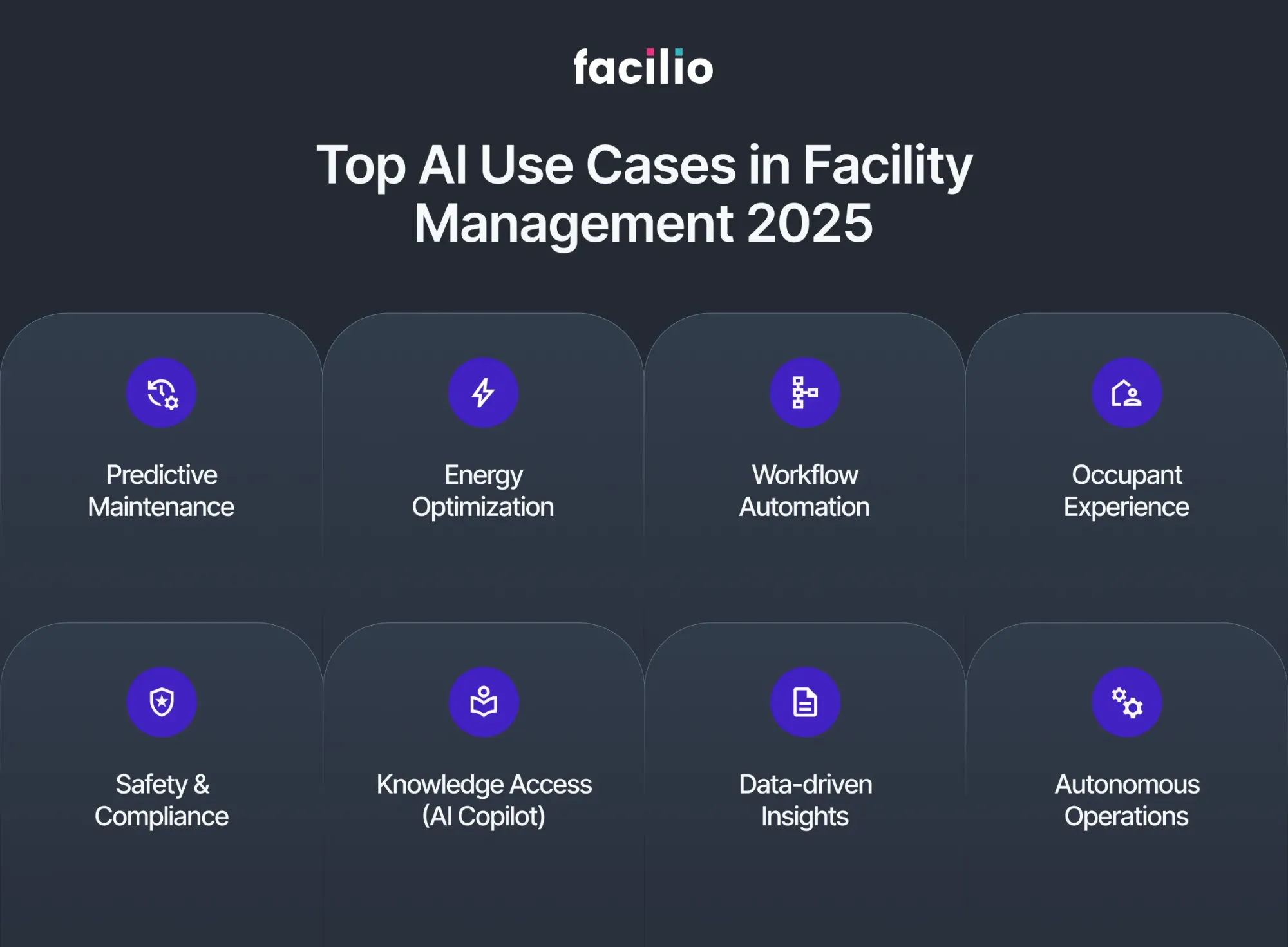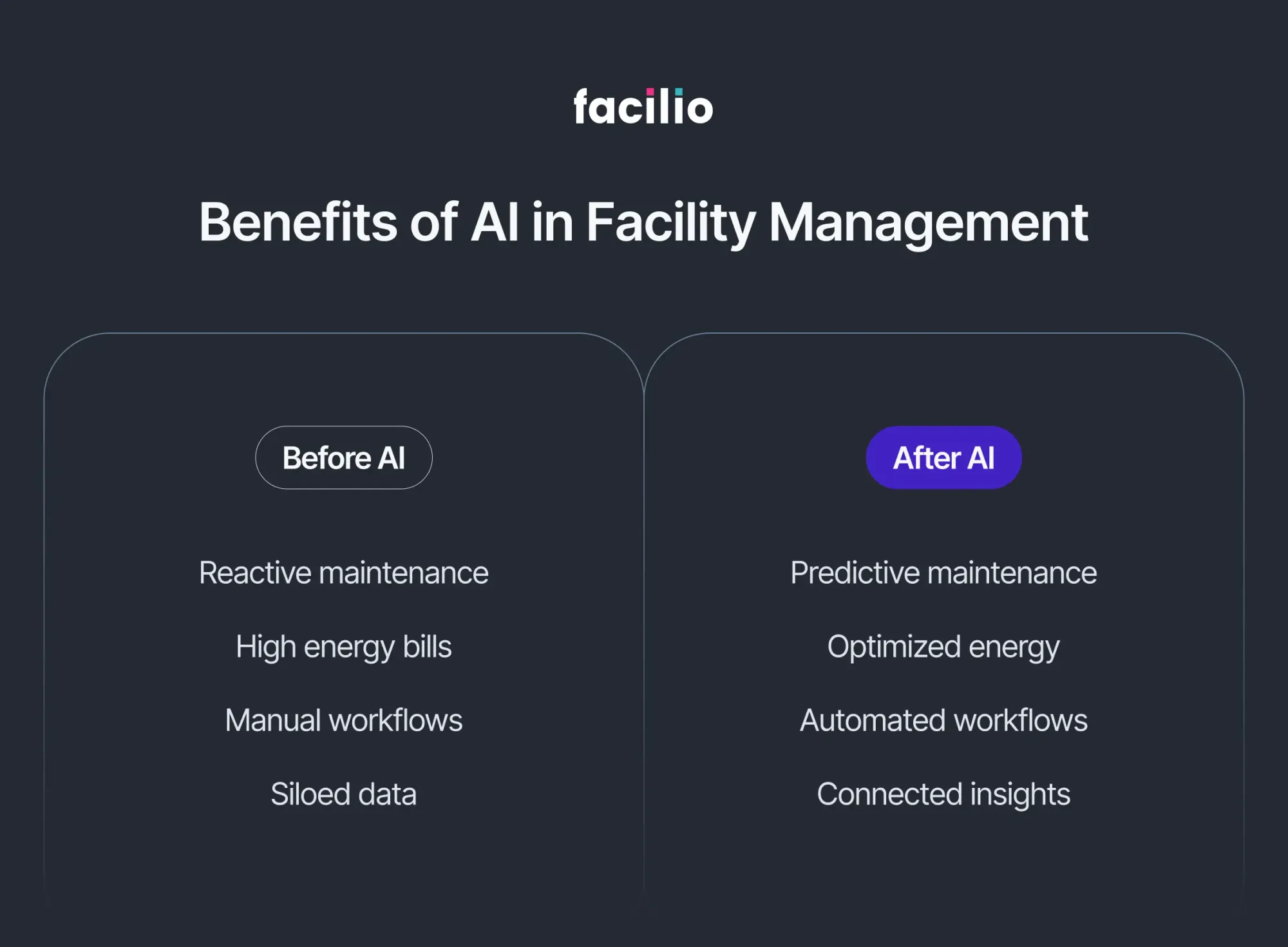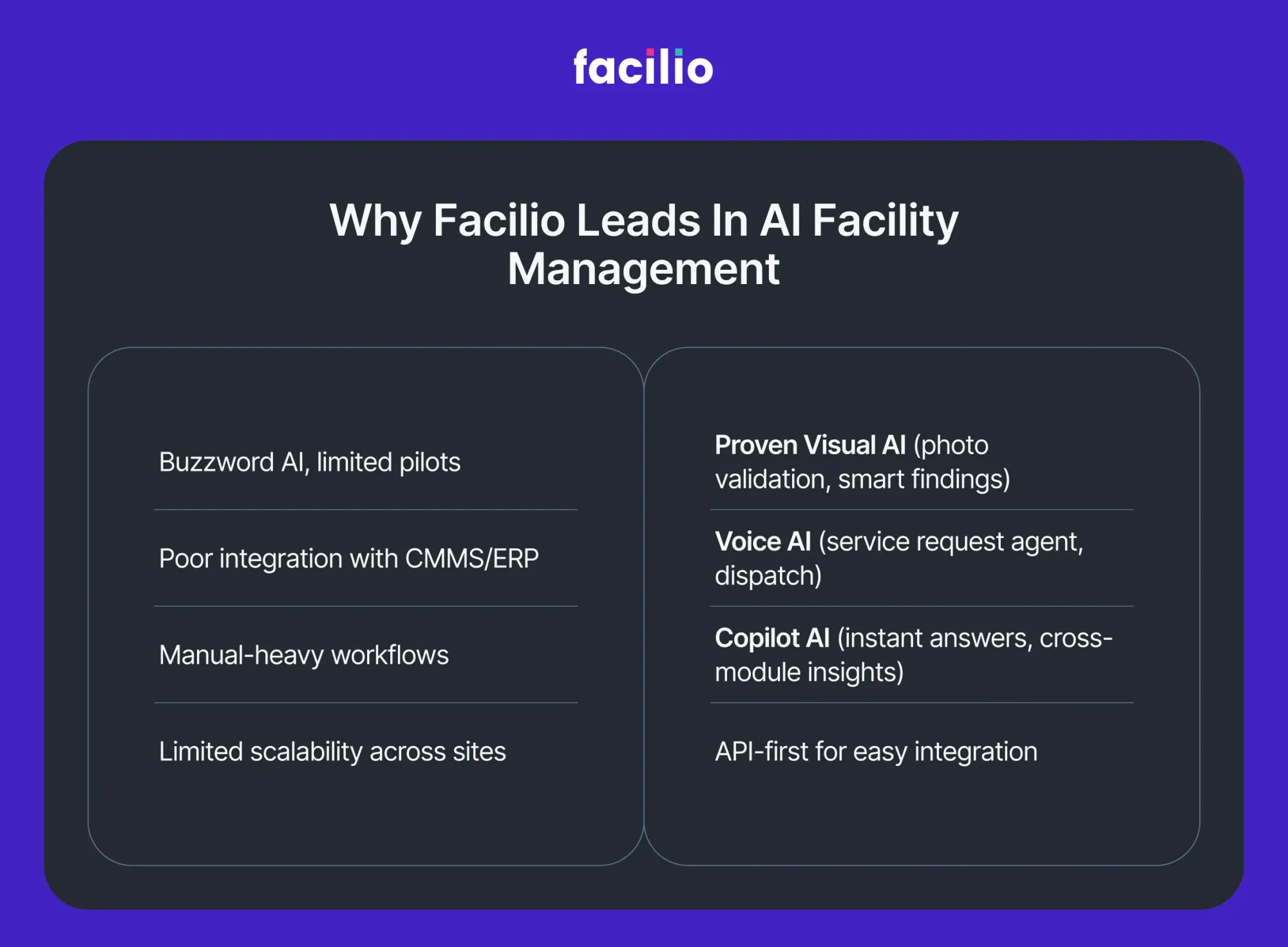We’ve been hearing about artificial intelligence for years, but in the last 2–3 years, something has shifted. With exponential leaps in computing power, AI has moved from being a buzzword to quietly powering real businesses — in logistics, agriculture, supply chain, and even heavy manufacturing.
Facilities management is no exception. AI is already working behind the scenes in many buildings, making them smarter, safer, and more efficient. The results are tangible: fewer surprise breakdowns, faster response times, and better service experiences for occupants.
AI in Facilities Management - A 5 Minute Explainer
And in 2025, its role in facility management is only set to grow and is growing.
So the pressure on facility leaders is clear: cut costs, meet sustainability goals, and keep tenants happy.
And this is precisely where AI is stepping in as the game-changer, learning from building data to predict problems, automate routine work, and create better spaces for people.
In this blog, we’ll break down the top AI use cases in facility management — what’s real, what’s next, and how forward-thinking companies are already putting them to work.
How artificial intelligence in facility management works
At its core, AI in facility management is about turning the endless stream of building data into decisions and actions that actually matter. Modern facilities already generate enormous amounts of information — from work orders and asset logs to occupancy patterns and service requests.
The challenge isn’t collecting the data, but actually making sense of it at scale. That’s where AI steps in.
Here’s how the loop works in practice:

- Spotting the patterns you might miss
AI studies both historical and real-time data to detect anomalies or trends. For example, it might notice that a pump consistently vibrates before failure, or that service requests for a particular HVAC system spike after seasonal changes. - Turning patterns into useful insights
Once patterns are clear, AI translates them into meaningful recommendations. It can suggest when to schedule preventive maintenance, flag recurring service issues, or alert managers about risks before they escalate. - Taking action without waiting for people
In advanced setups, AI doesn’t just recommend, it acts. For instance, it can auto-generate a work order when sensors detect irregularities, route service requests to the right technician, or prioritize jobs based on SLA urgency. - Learning and improving every day
Unlike static rules, AI continues to improve. Every new data point refines its predictions, making it more accurate over time. A CAFM system effectively “teaches” itself how to keep operations smooth with each new cycle. - Bringing everything together in one place (Cross-system intelligence)
The real power of AI lies in breaking silos. Work order histories, asset data, and compliance logs can be connected to give a complete view, like whether repeat breakdowns stem from vendor quality issues or equipment nearing end-of-life.
Let’s see how this plays out in real facility operations with some of the top AI use cases emerging in 2025.
Top AI use cases in facility management for 2025 and beyond
AI in facility management is moving from pilots to everyday practice. What used to be “nice-to-have” experiments are now delivering real savings, smoother operations, and happier occupants.

Here are the leading use cases you’ll see shaping facilities and how platforms like Facilio are already making them practical.
1. Staying ahead with predictive and prescriptive maintenance
Imagine this: instead of waiting for a pump to fail, AI detects early vibration patterns and triggers a preventive work order. Downtime avoided, service levels maintained, and your team looks proactive instead of firefighting.
Facilio takes this further with its work order completion validator.
By comparing before-and-after photos against job notes, it ensures tasks were completed properly — no rework, no disputes, just accountability.
2. Workflow automation
Paperwork may not sound glamorous, but it’s often where facility teams lose the most time. Invoices pile up, job logs go unchecked, and staff are stuck validating numbers instead of improving operations.
For instance, Facilio’s AI-based CMMS tool clears this bottleneck:
- Invoice & Payment Acceleration Agent — cross-checks quotes, jobs, and invoices automatically.
- Document Processing Suite — digitizes even handwritten records into structured, searchable data.
The result?
Approvals that take days instead of weeks and vendors who get paid on time. The agent also manages exceptions automatically, generates approval packets for faster validation, and provides analytics on invoice trends, giving finance teams greater transparency and control.
3. Making service requests seamless for occupants
Most occupant frustrations come down to one thing: “Why does it take so long to fix simple issues?”
Facilio’s AI service request & dispatch software solves this. It listens (via call, chat, or WhatsApp), troubleshoots basic issues, and routes the job instantly to the right technician — factoring in SLA, skill set, and location.
It also enriches tickets with the right details, proactively manages SLAs and escalations, and continuously learns from past requests to improve how future tickets are handled.
For tenants, that means faster fixes. For FM teams, it means fewer escalations and less pressure on helpdesk staff.
Note: Occupant-facing AI is one of the fastest ways to prove value to business leaders — it’s visible, measurable, and hard to ignore.
4. Keeping safety and compliance airtight
Here’s where AI moves from convenience to necessity. A missed hazard during inspection can turn into tenant disruption, fines, or worse.
Facilio’s Smart Findings feature analyzes inspection photos in real time, flagging leaks, damaged equipment, or safety gaps. It also generates structured reports automatically, so supervisors aren’t buried in paperwork.
Scenario: In a multi-building portfolio, AI spotted early signs of water damage during a routine photo capture. The fix was made in days, certainly not months, saving thousands in potential repairs.
5. Closing the knowledge gap for staff
Every FM manager has seen this: new staff asking for manuals, technicians calling supervisors for guidance, and hours wasted searching for compliance documents.
With Facilio, our FM Copilot feature puts all the knowledge at everyone’s fingertips.
Ask a question — “What’s the SOP for replacing a chiller valve?” — and it delivers step-by-step instructions along with past records.
6. Turning siloed data into actionable insights
FM teams are sitting on tons of data, but it often lives in disconnected systems. AI connects the dots, turning raw data into decisions.
With smart AI insights, managers can ask natural questions like:
- “Which site had the highest maintenance cost this quarter?”
- “Which vendors are missing SLA targets most often?”
Instead of juggling spreadsheets, you get answers in seconds.
Note: Bringing AI into quarterly reviews helps move discussions from anecdotal to data-driven.
7. Autonomous building operations
The long-term vision? Facilities that run themselves. AI and IoT-powered facility management workflows are paving the way toward autonomous operations — where issues are detected, validated, assigned, and closed with minimal human touch.
Facilio is already laying the foundation.
Disclaimer: We’re not fully there yet, but every incremental step — from AI-driven dispatch to automated invoice validation — brings facilities closer to autonomy.
Bring AI use cases to life with Facilio
From predictive maintenance to energy savings, see AI in action
SEE A DEMOWhat are the benefits of AI in facility management?
AI in facility management isn’t just about adopting new tech, but also about solving long-standing challenges in cost, efficiency, and experience.
Here are the core benefits facilities are seeing in 2025:

a) Cutting costs through smarter maintenance and energy use
Manual processes, duplicate work orders, and avoidable rework all drive up costs. AI helps cut these expenses by streamlining workflows, validating completed jobs, and reducing administrative overhead.
b) Freeing up teams to focus on higher-value work
Facility teams often spend more time on admin than on strategy. AI helps flip that equation. Workflows like invoice validation, meter logging, or inspection reviews can now run automatically in the background.
What used to take days — reconciling an invoice across multiple job logs — is handled in minutes. That translates into leaner teams, faster turnaround, and less burnout.
c) Strengthening compliance and audit readiness
Missed inspections or incomplete records can lead to fines and disputes. AI creates consistent, audit-ready logs of maintenance work, inspections, and service requests, ensuring compliance without adding extra effort for teams.
With the Document Processing Suite feature in Facilio's Connected CMMS, even scanned or handwritten inspection sheets become structured, searchable data, making compliance reporting faster and more reliable.
d) Improving decision-making with connected insights
Facility leaders often work with fragmented data across CMMS, CAFM, and vendor systems. AI brings it together, surfacing real-time insights that make planning, budgeting, and vendor management far more data-driven.
e) Creating better spaces and happier occupants
At the end of the day, facilities exist for the people using them. AI makes those spaces more responsive.
Whether it’s a system that automatically adjusts lighting based on occupancy or a service agent that instantly routes tenant requests, occupants notice the difference. Faster fixes, fewer disruptions, and more comfortable environments lead to higher satisfaction and often, stronger tenant retention.
Turn facility data into real-time decisions with AI
Facilio connects insights across maintenance, energy, and occupants
Book a live demo todayWhat are the challenges and considerations in AI adoption?
AI in facility management holds enormous promise, but adoption isn’t always straightforward. To get real value, facility leaders need to be mindful of a few key hurdles:
a) Getting the data right before expecting results
AI is only as strong as the data feeding it. Incomplete records, siloed systems, or inconsistent data entry can limit the accuracy of AI predictions. For many organizations, the first step is integrating data from existing FM stacks — CMMS, BMS, ERP — into a single source of truth.
b) Bringing people along with the technology
Even the best AI tools will fall short if staff don’t trust or adopt them. Facility teams may worry about automation replacing jobs or resist changing established workflows. Leaders need to invest in training, communicate the “why” behind AI adoption, and start with small wins that prove value.
c) Choosing the right AI partner, not just the loudest vendor
The market is crowded with “AI-powered” claims, but not all solutions deliver real outcomes. Selecting the right AI facility management company means looking beyond buzzwords. Key questions to ask:
- Can it integrate with your existing tools?
- Does it provide audit-ready evidence of work completed?
- Is the ROI measurable and tied to real use cases?
Facilio, for example, doesn’t just promise AI, but it actually delivers features like invoice acceleration, photo validation, and copilots that solve everyday FM challenges.
What to look for in an AI facility management company
Not every vendor that claims to be “AI-powered” can actually deliver on the promise. If you’re evaluating partners, here are the factors that separate the hype from solutions that really work:
1) Look for AI that’s working today, not tomorrow
Look for vendors that can show AI in action today, not just slide decks about future roadmaps. Can the system validate completed work orders with photos? Can it automatically read meters or speed up invoice approvals? If not, you’re buying ideas, not impact.
2) Make sure it fits seamlessly into your stack
AI doesn’t operate in isolation; it needs to work with your current CMMS, ERP, or BMS. A true AI partner will integrate easily, so you don’t end up with yet another silo. API-first platforms like Facilio are built with this in mind, making connections smoother and faster.
3) Check if it can scale across portfolios
Running AI at a single site is one thing. Scaling it across a campus, business park, or global portfolio is another. Make sure the platform can handle multi-building complexity without creating extra overhead. The right partner should grow with you, not hold you back.
4) ROI you can measure and defend
It’s easy to get excited about innovation, but business leaders care about numbers. Ask how the solution reduces costs, accelerates processes, or improves compliance in measurable terms. AI that can cut invoice validation workload by 70% or reduce energy bills by 25% is easier to justify than AI that “improves efficiency” in vague terms.
5) Choose a partner with depth, not just automation
Many tools stop at basic automation. Leaders should look for platforms that combine multiple AI dimensions — Visual AI, Voice AI, and Copilot AI — to address different parts of facility management. Facilio, for example, already delivers this trio, helping teams validate work, automate service requests, and unlock insights all in one platform.
How will AI reshape the future of facilities?
AI in facility management is still evolving, and 2025 is only the beginning. Here are the trends shaping where things are headed next:
1) Generative AI as a true assistant for FM teams
We’ve already seen copilots that answer questions and fetch documents. The next step is generative AI assistants that can draft inspection reports, summarize vendor performance, or even recommend negotiation strategies. For FM teams stretched thin, this means less time spent writing and more time acting.
2) Digital twins moving toward autonomous buildings
Digital twins — virtual replicas of physical spaces — are becoming practical with AI.
By combining real-time asset data, simulations, and predictive modeling, FM leaders can “test” operational changes before applying them. Imagine adjusting a maintenance schedule in the digital model, seeing the cost and downtime impact instantly, and then letting AI push the optimal schedule live.
And that’s exactly where real autonomy starts.
3) AI driving compliance and risk readiness
Compliance is only getting tougher, whether it’s safety inspections, SLA adherence, or tenant service standards.
AI will become the backbone of compliance, automatically generating audit-ready records and highlighting risks before they escalate. Instead of scrambling during audits, FM teams will have confidence that every inspection, service request, and work order is already tracked and validated.
Turn AI into measurable results for your facilities with Facilio
2025 isn’t just another year of buzz around AI; it’s the moment when facility management shifts from small-scale pilots to an AI-driven strategy at scale. The organizations that act now will see the clearest benefits: lower operating costs, smoother service delivery, stronger compliance, and facilities that adapt in real time to the needs of occupants.
But here’s the reality: not every “AI-powered” vendor is ready to deliver that future.
Many CMMS platforms still treat AI as an add-on, leaving customers with disconnected tools, integration headaches, and little to show in measurable outcomes.
Facilio is different. It is more than just a CAFM tool or a CMMS software with AI bolted on; it’s a connected operations platform built to make AI adoption seamless across every layer of facility management:

- Core maintenance workflows: Visual AI validates completed work orders, ensuring jobs are done right, and disputes are avoided.
- Service delivery at scale: Voice AI captures service requests across multiple channels and dispatches the right technician instantly.
- Compliance and safety: Smart AI-driven findings ensure inspections are consistent and audit-ready.
- Portfolio-wide intelligence: Copilot AI surfaces insights across sites, helping leaders make faster, evidence-based decisions.
Unlike traditional FM software, Facilio is built API-first, which means it integrates easily with your existing CMMS, CAFM, or ERP stack. This makes AI adoption practical, not painful — whether you’re managing a single building or an entire portfolio.
And that’s why forward-thinking facility leaders choose Facilio. It doesn’t just talk about the future of AI in facility management; it delivers it today.

